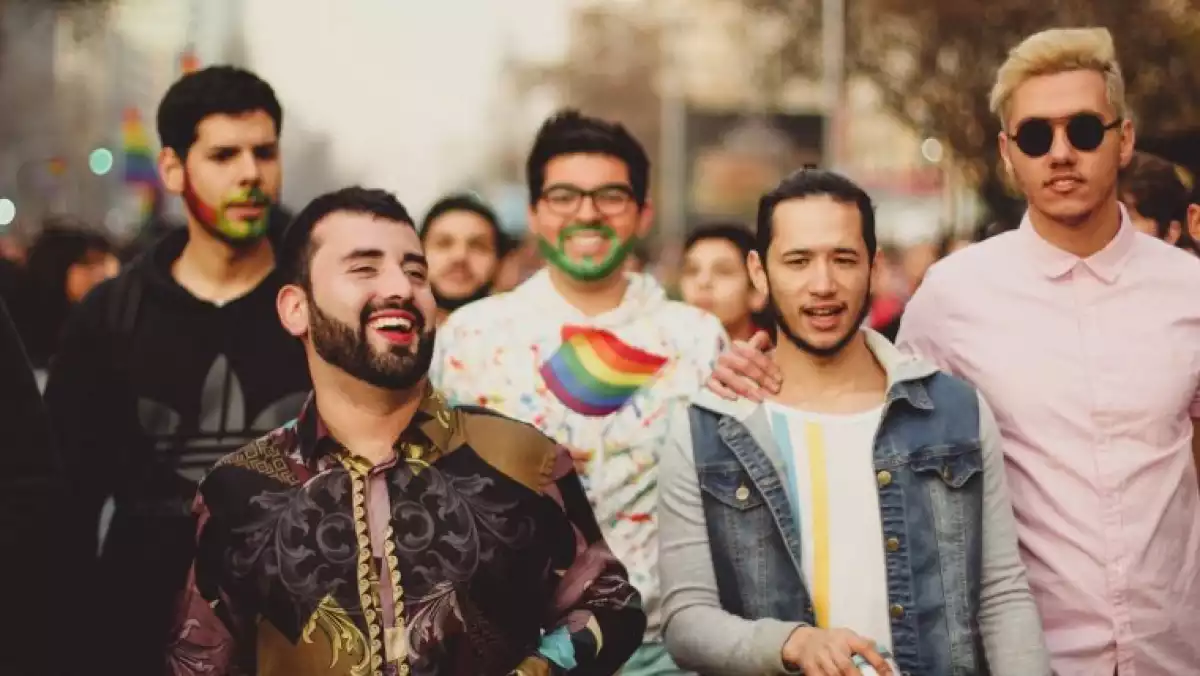Sexual orientation refers to physical and emotional attraction towards another person. This is different from gender identity and sexual differences, although sometimes people confuse these terms. In the following article, we explain everything about what sexual orientation is, and the different types of sexual preferences that are currently recognized, and how all of this relates to identity and biological sex. Finally, we'll take a look at what happens during one of the most crucial periods of life: adolescence.
Sexual orientation: a definition
The American Psychology Association defines sexual orientation as "an enduring pattern of emotional, romantic and/or sexual attractions to men, women or both sexes." This implies interest in a person due to different factors: biological, psychological, economic, cultural, religious, and social (Pérez, 2014).
Since this isan 'orientation,' it refers to a position or direction that something has; in this case, sexual desire. Although before (and even still in many contexts) heterosexuality was the only recognized possibility, but today many other sexual orientations are now coming to light. And, what does it mean to be heterosexual? Heterosexuality is an attraction to the opposite sex (men to women and women to men).
In Western society, this sexual orientation is the norm, meaning that it's the standard concerning desire and sexual experiences. Besides, throughout history, other sexual orientations and experiences that stray from the heteronormative have been labeled negatively. Homosexuality and bisexuality, along with more sexual preferences that we'll look at later on have been shunned. However, this is starting to change thanks to the demands of the LGTBQ community's movement.
Related: Relationship Anarchy: Attempted Definition
Is it the same as gender identity?
Gender identity is a separate matter from sexual orientation. While sexual orientation is attraction felt for someone, gender identity refers to the psychological experience linked to behavioral customs which can either be feminine or masculine. This is also related to biological sex which corresponds with the gender assigned upon birth, but not necessarily (in the case of Western societies, you are labeled a male if you are born with a penis and a woman if you are born with a vulva).
So, someone that identifies as a woman can have female gendered behaviors and a heterosexual orientation (this is what's generally expected by society), but not necessarily. On the other hand, a female could have a homosexual orientation. Or rather, the same person might not identify as a woman, but rather a man and have masculine behaviors and heterosexual tendencies. In this sense, there is a wide range of possibilities.
Gender vs sex
Sexual orientation is related to biological sex in the same way that it's related to other phenotypical characteristics of a person (like their skin color, facial features, etc.). This means that one doesn't determine the other: a person with any kind of genitalia could have any type of sexual orientation, which we will explain later on. Likewise, any person regardless of their biological sex might identify with the gender assigned to them upon birth (for example, a person with a vagina as a woman), but this isn't always the case.
This can get confusing since the gender binary in Western societies has lead people to ignore certain matters throughout the course of history. For example, the fact that 1% of babies are born with what is known as intersexuality (the presence of genetic, gonadal, and genital sex). However, by making different sexual identities more visible and even biological sexes, the existence of just two possibilities (male-female; feminine-masculine) is now strongly questioned.
Besides, heteronormative ideas about sexual orientation have also come into question, and along with this, people are realizing that sexual orientation, sexual identity, and biological sex aren't necessarily binary.

13 types of sexual orientation
So, now, you might find yourself wondering: what are the different types of sexual orientation? There are as many types as there are experiences and desires, plus: these different experiences and desires aren't necessarily incompatible. This means that they could even coexist within the same person. Now that people recognize other sexual orientations, they are starting to accept the fact that attraction or sexual preferences aren't necessarily a binary (there are more than two possibilities here).
Instead, there is more of a continuum (a phenomenon that happens without interruptions, with many different options). This continuum ranges from exclusively heterosexual to exclusively homosexual, or it can include traits from both or neither. And, explicit sexual behavior might manifest these preferences, but not necessarily. That said, below, we'll take a look at the 13 most recognized types of sexual orientation currently.
1. Heterosexual definition
As we mentioned before, this sexual preference means that an individual feels attraction on an emotional, romantic or sexual level to people of the opposite sex. For example, a man to a woman or a woman to a man.
2. Homosexual
Homosexuality refers to those with a sexual preference for people of the same sex. This means a man that's attracted to another man, or a woman that's attracted to another woman.
3. Bisexual definition
Bisexuality, on the other hand, is when one feels emotional, romantic, sexual, or affective attraction towards both sexes. In other words, when men have feelings for both men and women; or when a woman feels attracted to both men and women.
Together, homosexual and bisexual individuals have started a fight for the recognition of sexual diversity, having launched the LGBTI+ movement (lesbian-gay-bisexual-transgender-intersexual and more).
Related: Monogamy: Definition And How It's Different From Polyamory
4. Asexual definition
Asexuality is the lack of sexual, social, physical, or affective attraction towards others. Meaning that an asexual person doesn't feel attracted to any subject, no matter what their sex. That's why many consider this a 'lack' of sexual orientation. However, many stand up for asexuals, saying that asexuality is indeed a sexual orientation.
5. Pansexual meaning
Someone who is pansexual is attracted to any sex or gender. This means that a pansexual person might feel equally attracted on an emotional, romantic, sexual, or affective level to people of any sexual orientation or gender identity. Pansexuality is different from bisexuality since the latter stems from the gender binary, meaning, the idea that there are only two possible genders: male and female.
On the other hand, pansexuality works to bring sexual diversity beyond the binary to light, in a context where there can be more than two genders and sexes, as well as a wide range of possibilities for expressing them.

6. Demisexual definition
Demisexuality is a sexual preference where the individual needs to establish an emotional bond with someone first before they feel attraction. This means a demisexual person might not feel sexual or affective desire for someone until they get to know them well and they can trust this person.
For the same reason, demisexuality was once considered a variety of asexuality. But today, it's recognized as a separatesexual orientation since the possibility of feeling physical and emotional attraction towards someone still exists, but only after getting really close to this individual.
7. Anthrosexual
Anthrosexuality is a non-defined sexual orientation, which means that individuals that identify as anthrosexual make connections with all different types of people. So, some might consider this type of sexual preference a sort of mix between bisexuality and pansexuality, although they don't identify exclusively with either of these.
Related: 10 Types Of Feminism
8. Autosexuality
Autosexuality is when an individual feels sexually attracted to himself or herself, which means that they have autoerotic tendencies.
9. Graysexuality
Graysexuality is the sexual preference that represents the most substantial part of the sexual desire continuum. This is a sexual orientation located between the two poles of desire: asexuality and sexuality. A graysexual person isn't exclusively sexual or asexual. Instead, they move from having sexual feelings to being asexual during different phases of their life.
10. Hyposexuality
Hyposexuality is practically the same as asexuality (a lack of sexual, emotional, or affective attraction to anyone). The difference is that, while asexuality defines someones sexual preferences as a norm, hyposexuality is a consequence of external factors like too much stress at work, or even the result of a medical condition. On the same note, in some contexts, it isn't defined as a sexual orientation, but instead, a transitional phase caused by external factors.
11. Lithsexuality
The main characteristic of lithsexuality is that the person feels physical and emotional attraction towards a person, regardless of whether this feeling is corresponded. Reciprocity in desire and sexual interest isn't a determining factor for someone lithsexual to feel attraction.
12. Sapiosexuality
The word 'sapio' comes from Latin and means 'wise.' So, the definition of sapiosexuality is a fixed attraction towards people that they consider intelligent. Sapiosexual people feel attracted to others due to their cognitive and emotional abilities, through which they are able to make fundamental intellectual connections.
13. Skoliosexuality
Skoliosexual individuals feel attracted to transgender and intersexual people, or other people with more open gender identities. This means that a skoliosexual person doesn't feel attracted to cisgender individuals (people who identify with the gender assigned to them at birth), instead, they are drawn exclusively to people with open sexual identities.

Queer meaning
The word 'queer' originally meant "strange" or "peculiar," and throughout history, it has been used as a derogatory term to refer to people who aren't straight or heterosexual. This is a concept traditionally used to talk about sexual minorities; in other words, those who break heteronormative ideas (that don't fit the traditional gender binary).
However, towards the end of the 20th century and the beginning of the 21st, the LGBTI+ community began the reappropriation of the word 'queer' to reclaim sexual diversity and the right to experience their sexual orientation freely.
And thus, the word queer refers to those with fluid sexual orientations and gender identities. In this sense, the concept is similar to skoliosexuality, although it also encompasses almost all of the sexual orientations we mentioned before (since they all question heteronormativity).
Related: 8 Types Of Relationships And Dating
Adolescence and sexuality
People often wonder at what age sexual orientation and sexual identity are established. Is this set in stone at a certain point in time? The answer is: no, not necessarily. Traditionally, adolescence is a phase in life where different expectations are set, and social roles are established, and sexual orientation is also often conceived around this time as well.
However, current evidence shows that this doesn't necessarily happen during the teenage years and, if it doesn't, then it doesn't necessarily occur within any specific time frame. However, this doesn't make adolescence any less significant when it comes to psychological conflicts regarding sexuality, especially since it opens up different environments with different rules.
On the same note, this is complicated by the sheer quantity of misinformation and stereotypes out there regarding sexuality, particularly in the settings where young people hang out. So, something fundamental during this period is having access to enough basic information on gender identity and sexual orientation, valuing the richness of human diversity, and being sure to avoid imposing ideas without listening and having an inclusive attitude.
Offering different role models favors self-knowledge, and therefore self-assuredness. Plus, it helps to improve one's ability to coexist with others and to take responsibility for decisions consciously.
- This article about "Sexual Orientation" was originally published in Spanish in Viviendo La Salud
References
American Psychology Association. (2018). Sexual orientation and gender identity. Retrieved January 8, 2019. Available at https://www.apa.org/helpcenter/sexual-orientation
Calvo (2018) Las identidades de género según las y los adolescentes. Percepciones, desigualdades y necesidades educativas. Contextos Educativos (21): 169-184.
De la Torre, V.M. (2017). Identidad de género, una categoría para la deconstrucción. Revista Xihmai XII (23), 83-102.
Martell, N.G., Ibarra, M.L., Comtreras, G., Camacho, E.J. (2018). La sexualidad en adolescentes desde la teoría de las representaciones sociales. Psicología y salud. (28): 15-24.
Mercado Colmenero, R. (2018). Rompiendo la brecha de la heteronormatividad. Identidad de género y nuevas tendencias sexuales en educación primaria. Revista internacional de apoyo a la inclusión, logopedia, sociedad y multiculturalidad. 4(3): 165-173.
Pérez Borge, D. (2014).La orientación sexual como continuo.Revista insight. Spain.
Stuardo, S. (2015). Skoliosexual: conoce el significado detrás de está desconocida orientación sexual. Bibiochile.cl. Retrieved January 8, 2019. Available at https://www.biobiochile.cl/noticias/2015/10/30/skoliosexual-conoce-el-significado-de-esta-desconocida-orientacion-sexual.shtml
